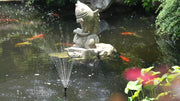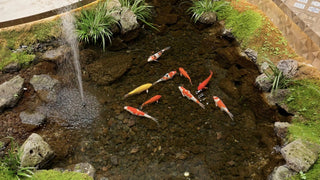
You finally installed that waterfall and stocked the pond with shimmering koi—only to discover the electric bill creeping up every month. Friends say they shut their pumps off at night. Forums warn that doing so will ruin water quality. So what’s the real answer for a modern hobbyist juggling beauty, fish health, and energy costs? Below you’ll find a straight-talking guide that explains why most ponds benefit from 24/7 circulation, when short pauses are perfectly safe, and how Poposoap’s solar-powered line lets you keep water moving without watching the meter spin.
A Common Pond Owner Question
Every new keeper reaches the same crossroads: “Do I really need to run my pond pump all the time?” Part of the confusion comes from terminology. A circulating pond pump does far more than push water up a fountain. It oxygenates fish gills, feeds the biological filter, carries debris to the skimmer, and drives UV clarifiers. Turn it off too long and a seemingly tranquil pool can flip from oasis to headache overnight. Understanding that relationship between fish pond and pump is the first step to making a confident decision.
Why Continuous Operation Is Recommended

Oxygen for Fish and Bacteria
Koi and goldfish gulp oxygen dissolved in moving water. The same flows power bio-colonies that strip toxic ammonia and nitrite. Shut down the pump for eight hours and dissolved oxygen (DO) can plummet by 50 percent—especially in warm summer water when fish metabolism is highest.
Debris Transport
Leaves, pollen, and fish waste need a steady current to reach mechanical pads. Without flow, solids fall to the bottom, where they break down into sludge that fuels algae blooms and sulfurous odors.
Thermal & Chemical Stability
Pumps blend cold bottom layers with warmer surface water, evening out temperature swings and preventing CO₂ buildup overnight.
In short, around-the-clock circulation is insurance that your pond equipment—filters, UV clarifiers, aerators—works as an integrated system instead of a group of part-time employees.
What Happens When You Turn Off Your Pump?

- Stagnant Pockets Form – Organic debris settles; anaerobic bacteria start producing hydrogen sulfide within hours.
- Filter Bacteria Suffocate – Nitrifying microbes need oxygenated water flowing past their bio-media. Six to eight hours offline can wipe out up to half the colony, forcing a mini “new-pond” cycle when you restart.
- pH Swings Overnight – CO₂ accumulates in still water, lowering pH and stressing gill tissue.
- Predators Thrive – Mosquitoes lay eggs in glassy surfaces, and raccoons can stalk fish more easily in calm shallows.
That’s why seasoned keepers list a silent pump as the first sign something is wrong with their equipment for ponds.
Exceptions: When It’s Okay to Turn It Off

While continuous flow is best, there are moments when shutting down briefly causes no harm:
- Filter Maintenance – Rinsing pads or back-flushing a canister takes ten to fifteen minutes. Keep a battery-powered Poposoap Solar Pond Aerator bubbling while the pump is disconnected to maintain oxygen.
- Severe Freezing – In regions where ice thickness threatens plumbing, draining and storing an AC pump is prudent. Pair a small solar aerator with a floating de-icer to keep an air hole open until spring.
- Emergency Electrical Work – If an electrician needs circuits dead, unplug the pump. Just remember your biofilter timer starts ticking; aim to restore flow within four hours.
- Wildlife or Plant Ponds – Very small, plant-heavy habitats with no fish can thrive on passive oxygenation. Even there, a low-watt fountain run a few hours daily helps prevent mosquito issues.
Outside those cases, continuous operation remains the gold standard for fish welfare and water clarity, especially in a koi pond equipment setup where waste output is high.
Energy-Efficient Alternatives

Running 24/7 doesn’t have to equal a 24/7 expense. Poposoap’s solar-driven lineup was designed precisely to solve the “always-on” dilemma:
- Solar Fountain Pumps (6 – 70 W) – Panel-powered mag-drive units that lift streams up to 13 ft, ideal for waterfalls or spitters without trenching wire.
- Solar Pond Filters – All-in-one boxes combining a DC pump, mechanical pads, and Bio-Balls. They operate dawn-to-dusk on sunlight, then switch to lithium battery backup for evening circulation.
- AC Pond Pumps With Ultra-Efficient Motors – For shaded yards, Poposoap’s 12W, 20W, and 30W models deliver robust turnover while sipping less power than a 40-W light bulb.
- Modular Aerators and Clip-On UV Clarifiers – Add targeted oxygen or algae control without upsizing the main pump, keeping total wattage low.
By choosing gear that matches real-world head height and flow needs, most owners cut annual electricity costs by 40–80 percent—all while keeping the pump on.
Tips to Reduce Energy Use Without Sacrificing Water Quality
- Right-Size the Pump – Calculate pond volume (L × W × Avg Depth × 7.5) and buy a unit that turns the pond once per hour at your actual head height. Oversized pumps waste watts.
- Use Valves Instead of Larger Motors – Split a single flow to both waterfall and filter with a Y-valve; throttling one line often beats buying two pumps.
- Add Bio-Surface, Not Flow – If tests show ammonia near zero, focus on more bio-media rather than more gallons-per-hour. A bag of Poposoap Bio-Balls in the filter multiplies bacteria housing without increasing electricity.
- Leverage Solar Daylight – Let a solar pump or aerator shoulder daytime circulation, then keep a lower-watt AC backup running at night for baseline oxygen.
- Clean Impellers Monthly – Debris-gummed rotors draw extra current; a five-minute toothbrush scrub restores efficiency.
- Shade the Surface – Lotus, water lilies, or a floating Poposoap Fountain reduce direct sun, cutting summer water temps and slowing algae metabolism, which lowers the bio-load your pump must handle.
Combine these tactics and you can leave the pump humming guilt-free.
Conclusion: Leave It On for a Healthy Pond
A pond may look peaceful, but below the mirror busy biology never sleeps. Continuous circulation is the simplest, safest way to keep that invisible engine firing on all cylinders. While brief shutdowns for maintenance or winterization are harmless, routine overnight silence risks fish health, water clarity, and expensive filter bacteria die-offs.
With today’s solar innovations from Poposoap—plus smarter sizing, shading, and filtration—running a pond pump 24/7 is no longer an energy burden. It’s a low-cost guarantee that your backyard refuge remains clear, oxygen-rich, and dazzling every time you step outside. Leave the pump on, let the ecosystem thrive, and reserve your worries for bigger things—like which new koi variety to add next.










